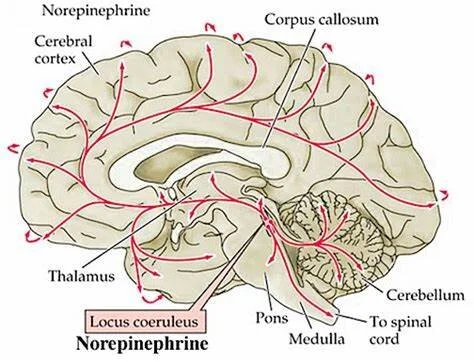Answer: The most important source of norepinephrine in the brain is a small region of the pons called the locus coeruleus.
Norepinephrine is best known for its function in activating the sympathetic nervous system, the branch of the autonomic nervous system that results in preparing the body for a state of high physical activity (fight or flight response.) In the brain, norepinephrine is important for such cognitive functions as alertness, memory, and attention.
The biosynthesis of norepinephrine begins with the amino acid phenylalanine. Through the action of the enzyme aromatic amino acid hydroxylase (AAAH), phenylalanine becomes converted into L-DOPA. The enzyme aromatic amino acid decarboxylase (AADC) converts L-DOPA into dopamine, the immediate biochemical precursor to norepinephrine. Finally, the enzyme dopamine beta-hydroxylase (DBH) converts dopamine into norepinephrine.
Norepinephrine is not widely synthesized in the brain. Instead, it is produced primarily by a clump of neurons in the pons of the brain stem. This region is called the locus coeruleus, named because it has a slightly bluish tinge under a light microscope. When norepinephrine polymerizes, it forms neuromelanin, which is heavily pigmented. It consists of about 50,000 neurons in a typical human brain.
Other sources of norepinephrine
The sympathetic ganglia, a chain of clumps of neurons that run parallel to the spinal cord along the dorsal side of the body, produces norepinephrine that modulates the activity of the internal organs in the "fight-or-flight" response.
There is also a region of norepinephrine producing cells in the adrenal medulla. These cells release norepinephrine into the bloodstream as a neurohormone.
Connections of the locus coeruleus
The locus coeruleus sends widespread projections to several areas of the brain. LC releases norepinephrine into the hypothalamus, the thalamus, limbic areas such as hippocampus and amygdala, and the cortex.
The inputs of the locus coeruleus include connections from the medial prefrontal cortex. These are tonic excitatory glutamatergic projections, and increases in this neural activity is observed when a person is more alert.
